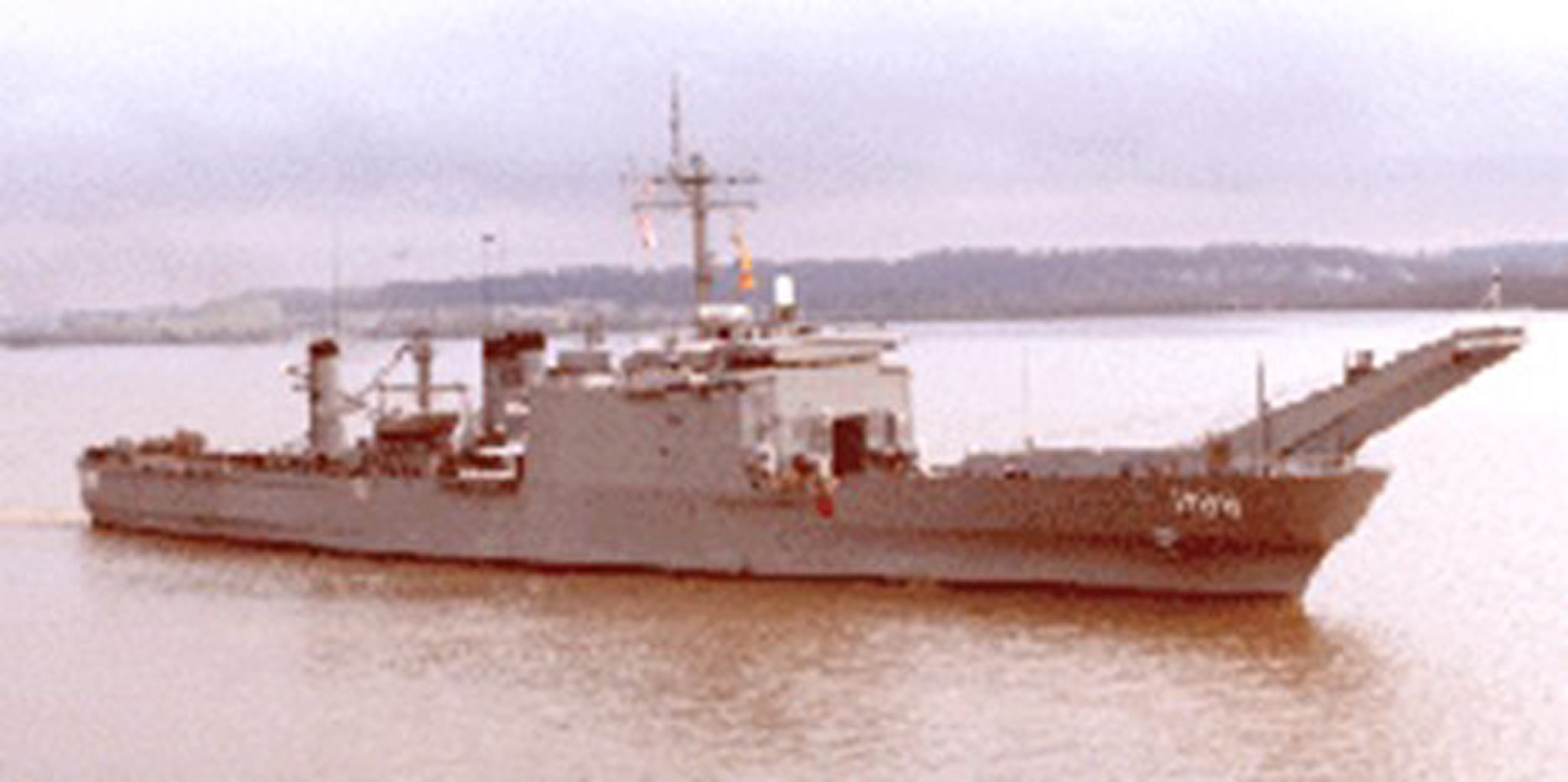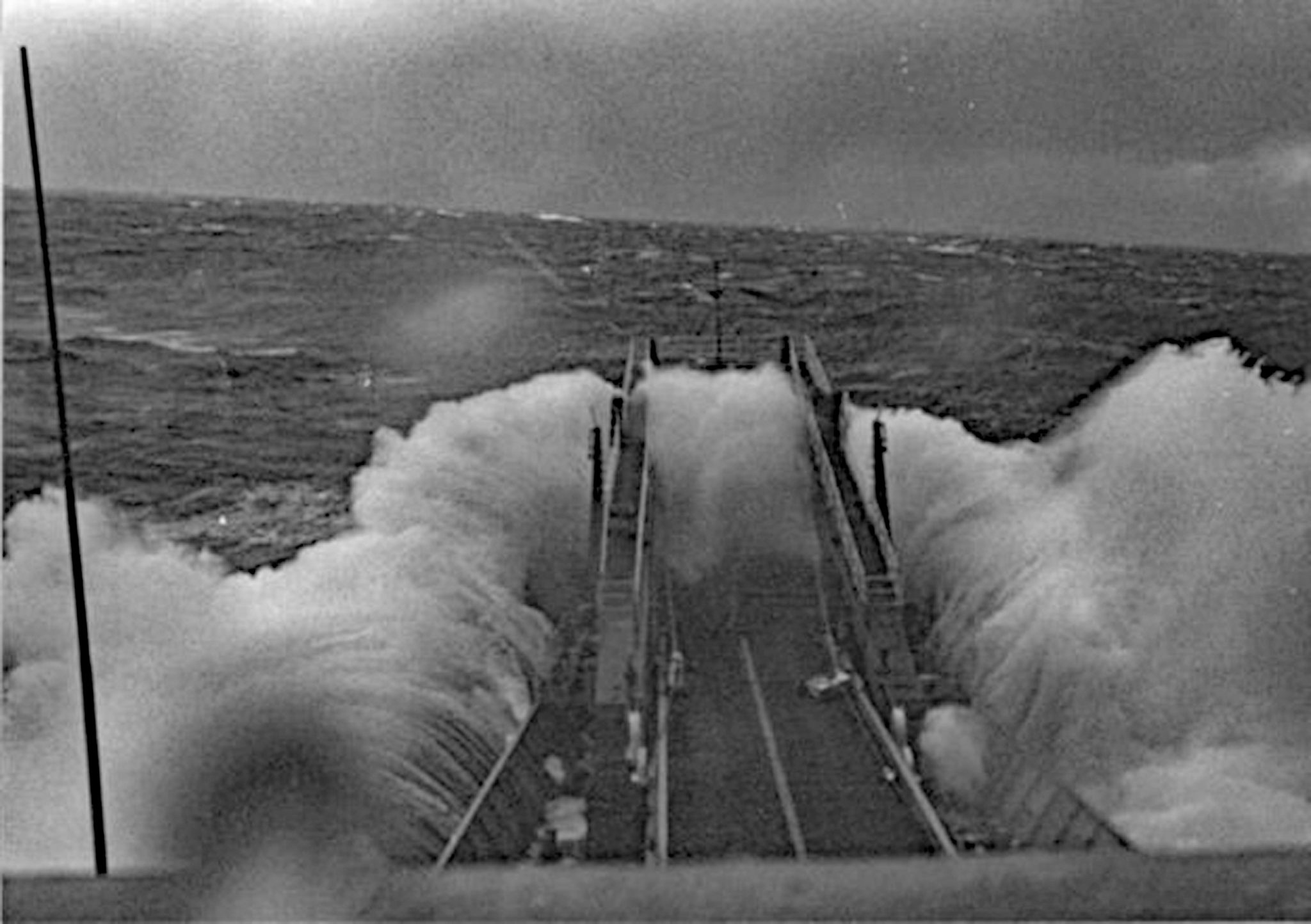The Last Word – An Ordinary Night

Alexandria, VA – It was a brilliant night at sea. The USS SAN BERNARDINO (LST 1189) was calmly lumbering along with seven other ships in our imaginary box on the Camel Crossroads Station map in the Arabian Sea. We had been boring a hole in the ocean for six weeks, dutifully driving around in our box, waiting for some movement to our north in Iran.
I awoke at 2300 (11:00 pm) and prepared for the midwatch – midnight to four in the morning. I showered, shaved, got into my khaki uniform, ate a bowl of cereal, grabbed coffee, and sleepily climbed the steps to the Combat Information Center (CIC) to be briefed before going on watch on the bridge. Lieutenant Bob Kornman walked me around CIC, pointing out the ships in the formation, where they were, their radio callsigns, our navigation position, and the whole tactical situation – the usual start of yet another four hours of mind-numbing boredom on watch, struggling to keep one’s eyes open. The routine it had been for eight weeks.
It was coal black as I walked into the pilothouse. One stands for a few seconds when walking into the pilothouse to acclimate your eyes to night, allowing the darkness to melt away, with the low red glow of radar screens and communications sets the only light.
“Good morning, Mister Fisk,” a faceless voice chirped from behind the ship’s helm.

“Sure. And a pleasant good morning to you, too, Mister and Mrs. Cleaver,” I responded in my best Eddie Haskell.
I opened the captain’s night orders book and read what the captain wanted his watch officers to be prepared for. Strange – nothing written in the night order book. Puzzled, I walked forward to the bridge window and finally made out the face of Lieutenant Mark Samuels. I saluted and mumbled, “I’m ready to relieve you, sir.”
“I’m ready to be relieved.” Mark let out an exhausted sigh; the irony in his voice hung heavy in the air.
Normally, Mark would take me around the pilothouse, repeating everything I had picked up from Bob in CIC. That would be followed with the main engine status, steering gear, steering course and magnetic course, and anything else that would prepare me to take over the watch as the conning officer – the person who gives all the commands to the helm and engines – what we call driving the ship. The conning officer reports to the officer of the deck (OOD), the captain’s most trusted player on the bridge and the go-to person, the acting captain, responsible for everything during the four-hour watch.
The sleepy midwatch that we were all used to, however, wasn’t there. The pilothouse was alive with squawking radios, people darting in and out, and feverish chatter.
“Silence on the bridge,” Mark punctuated the night. The chatter dropped to whispers. Mark turned the blistering radios down to a dull roar. He could see the puzzled look on my face.
“I’m not sure what’s going on,” he said. “The captain, X.O. (the executive officer), Ops (operations officer), and Commo (communications officer) have all been in Radio Central with the code books. No one has come out for two hours.
“It’s chaos on the radios. I’m hearing American voices – clearly, they’re American — but the callsigns are not in the books. Crazy callsigns. We have no idea who these guys are talking to on the radio. And there are dozens of helicopters flying all over the place. I don’t know what’s going on, but something’s happening and it’s big.”
“So, any advice? What are we doing, and what should I do?”
“I don’t know. Stay in our assigned box and drive around until we know what’s going on. Sorry, I can’t be any help, but I’m clueless, too.”
I saluted him and said, “I relieve you, sir.” Mark saluted back and said, “I stand relieved. In the pilothouse, this is Mister Samuels. Mister Fisk has the conn.”

A modified stillness returned. The rest of the night was filled with only essential comments on the ship’s status. The helicopters and radio traffic continued but somehow seemed more manageable. We settled into our routine and the four-hour watch ebbed into posterity. At 0400, I left the bridge, walked back to my stateroom, slipped out of uniform, and curled into my bunk to catch two hours’ sleep before the day started.
Morpheus was just taking hold when the door flew open and the lights switched on. Standing there was Lieutenant Bob Gessner, the operations officer. Bob was an agitated guy in everyday life, but that usual fever pitch was surpassed by the Bob standing in the doorway.
“Get up! We’re going to general quarters in two minutes!” He left abruptly. Sure enough, two minutes later, “On the San Bernardino – this is not a drill – general quarters – general quarters – all hands man your battle stations.”
Then a klaxon sounded. That frightening sound is shattering enough for civilian ears. To a sailor, it makes the hair stand on end, your adrenaline pump beyond imagination, and your usual quick gait becomes a frantic dash, slamming into others in the passageways and arriving at your station out of breath and still dressing while adding battle helmets and safety measures in the event of fire or flooding.
It was 4:17 am, 25 April 1980. As night became day, our crew stood by their stations, wondering why we were there, what had happened, and what would happen next.
Two hours later, the captain came on the ship’s system to give a short update. He said U.S. forces had attempted to rescue the U.S. citizens held hostage in Tehran, Iran, since the previous November. He said that’s all he could give us right then and to expect to remain at battle stations for the immediate future, that he didn’t know what to expect so we should all be alert.
One enterprising sailor, an ammunition handler for one of the ship’s two guns, had a short wave radio in the gun mount. He tuned to Australian Broadcasting and listened as the news was reported. He told one of the ship’s telephone talkers what had happened, who passed it to the crew. A helicopter had collided with a U.S. C-130 cargo aircraft. The explosion resulted in casualties, but no details were available.
This was the first, albeit scant, information we received about OPERATION EAGLE CLAW, the ill-fated special ops effort to free the American hostages. The world learned what was happening live, but onboard the ships on station in the Arabian Sea, we were entirely in the dark.
When our troops in Iran withdrew and the immediate threat of a counterattack waned, we spent two days at modified battle stations.
In the years after OPERATION EAGLE CLAW, serious flaws in our military capabilities were revealed. Those flaws were scrupulously analyzed and massaged, and new operations and forces created to make sure we were ready to handle the unique situations that became more prevalent.
What did that night mean to the 200 sailors on the SAN BERNARDINO? When we finally stood down and returned to our regular, plodding routine, boring holes in the Arabian Sea, you could hear a new buzz among the crew. Those diverse, sometimes professional, sometimes whacky, sometimes outlaw sailors swapped stories at the mess table and walked through the ship, laughing, grinning, and slapping one another on the back about our two days at war.
Fortunately, it didn’t go that way, but these guys had flipped the switch from peacetime sailors to hardened, ready sea dogs. That’s what sticks in my mind some 43 years later. I can still feel it all.
ICYMI: Alexandria Officials Help Students ‘Dig Into School Breakfast’




